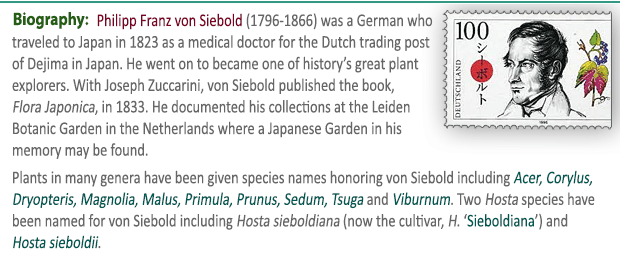|
  A rapid growing,
medium size (12 inches high) hosta,
'Lemon Lime' is great for edging beds and borders. It was
registered by
Robert Savory
of Savory's Gardens in Minnesota in 1977 as a seedling of
H. venusta. The foliage is narrowly ovate shaped, slightly wavy and has thin textured.
It bears bright purple flowers in July and may re-bloom in
September. A rapid growing,
medium size (12 inches high) hosta,
'Lemon Lime' is great for edging beds and borders. It was
registered by
Robert Savory
of Savory's Gardens in Minnesota in 1977 as a seedling of
H. venusta. The foliage is narrowly ovate shaped, slightly wavy and has thin textured.
It bears bright purple flowers in July and may re-bloom in
September.
The Book of Little Hostas by Kathy and Michael Shadrack
(2010) says: "Very fast growing...A very easy to grow variety that
will eventually get quite large if left undisturbed. Regular division yields
plants to edge a bed or pathway...should be kept out of strong sunlight."
The New Encyclopedia of Hostas by
Diana
Grenfell (2009) states: "Origin:
H. sieboldii var. sieboldii derivative...Does
not tolerate sun. Vigorous, one of the fastest-growing hostas.
Can easily exceed its registered dimensions. Three flushes of
leaves may be produced each season. Some rebloom is possible in
late summer if the first scapes are cut to the ground after
flowering. Leaves maintain chartreuse unless the hosta is grown
in bright light...Tall scapes rising above dense carpets of
pointed leaves."

 An article by
Bob Solberg in
The
Hosta Journal (1994 Vol. 25 No. 2) states that "Bob
Savory's 'Lemon Lime' and 'Golden
Tiara', both registered in 1977, are hosta breakthroughs,
but not because H. nakaina is their parent. (It is also
the parent of many of
Eunice
Fisher's small-to-medium sized hybrids.) Rather it is
because of their bright spring color and extremely fast rate of
increase. 'Golden Tiara' is often listed as a H. nakaiana
hybrid, as 'Lemon Lime' is, but it is really an induced mutation
of a H. nakaiana seedling. An article by
Bob Solberg in
The
Hosta Journal (1994 Vol. 25 No. 2) states that "Bob
Savory's 'Lemon Lime' and 'Golden
Tiara', both registered in 1977, are hosta breakthroughs,
but not because H. nakaina is their parent. (It is also
the parent of many of
Eunice
Fisher's small-to-medium sized hybrids.) Rather it is
because of their bright spring color and extremely fast rate of
increase. 'Golden Tiara' is often listed as a H. nakaiana
hybrid, as 'Lemon Lime' is, but it is really an induced mutation
of a H. nakaiana seedling.
In an effort to create hostas that rapidly increased, seven
hundred fifty H. nakaiana seedlings were treated with a
mixture of hormones and vitamins. The sport of one of these
seedlings was named 'Golden Tiara'. No hostas compare with these
two of Savory's for rate of increase or repeat blooming
throughout the season."



|



